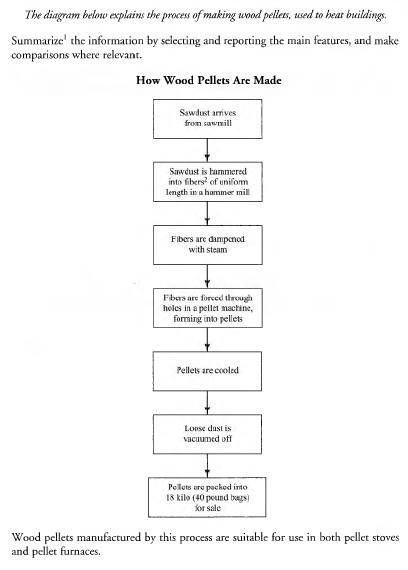The flow chart reveals how to make wood pellets in order to heat the buildings. Overall, there are two forms of wood before being pellets. It is also essential to note that the sawdust passes three physical process and two temperature treatments to create pellets.
To begin with, sawmill's waste form is changed two times. The first, sawdust is an original material then it becomes smaller form which is fibers. After several treatments, they turn to be pellets. Nest, the pellets are packaged to bags for marketing.
Interestingly, to create pellets there are three physical treatments which are hammering, forcing, and vacuuming, while the temperature-control treatments are also needed in which dampening and cooling are part of them. Move to more detail analysis, the first process, sawdust passes hammering to create smaller forms and then fibers formed and they dampened with steam. Furthermore, they are forced to become pellets. To produce the final product of pellets, preservation is needed in order to make them ready to be sold. The fresh pellets then are cooled to make them durable. The last process is to do vacuuming and packaging the pellets to specific weight and cover. Most of the time, pellets are put into bags which have increase-capacity about 40 pound or 18 kilo of pellets per bag to be released to the market.
To begin with, sawmill's waste form is changed two times. The first, sawdust is an original material then it becomes smaller form which is fibers. After several treatments, they turn to be pellets. Nest, the pellets are packaged to bags for marketing.
Interestingly, to create pellets there are three physical treatments which are hammering, forcing, and vacuuming, while the temperature-control treatments are also needed in which dampening and cooling are part of them. Move to more detail analysis, the first process, sawdust passes hammering to create smaller forms and then fibers formed and they dampened with steam. Furthermore, they are forced to become pellets. To produce the final product of pellets, preservation is needed in order to make them ready to be sold. The fresh pellets then are cooled to make them durable. The last process is to do vacuuming and packaging the pellets to specific weight and cover. Most of the time, pellets are put into bags which have increase-capacity about 40 pound or 18 kilo of pellets per bag to be released to the market.

task_1_scoring_3.jpg
